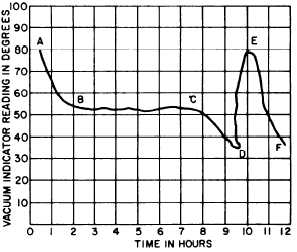8-27.
During plant operation, which of the
following symptoms will indicate a
clogged R-12 liquid line strainer?
1.
The temperature of the tubing on the
outlet side of the strainer is much
warmer than the tubing on the inlet
side
2.
The temperature of the tubing on the
inlet side of the strainer is much
warmer than the tubing on the outlet
side
3.
The pressure on the outlet side of
the strainer tubing is much higher
than on the inlet side
4.
The pressure on both the inlet and
outlet sides of the strainer tubing
are the same
8-28. Which action should you take prior to
tightening the cap on a liquid line
strainer that has been cleaned?
1.
Test the strainer for leaks
2.
Open the strainer outlet valve
3.
Purge the air out of the strainer
4.
Replace the strainer screen spring
8-29.
Which of the following conditions may be
caused by excessive buildup of frost on
the cooling coils?
1.
Low suction pressure
2.
High suction pressure
3.
Both 1 and 2 above
4.
High condensing pressure
8-30.
Which of the following factors help(s)
determine the maximum time between
defrosting of the cooling coils?
1.
Amount of refrigerant in the system
2.
Moisture content of the supplies
3.
Amount of heat to be removed
4.
All of the above
8-31.
Cooling coils should be defrosted before
the frost thickness reaches
1.
1/4 in.
2.
3/16 in.
3.
1/8 in.
4.
5/16 in.
8-32.
8-33.
8-34.
8-35.
Questions 8-32 and 8-33 are based on
Figure 8-A.
Approximately how many inches of mercury
represent the difference in temperature
between points B and D?
1.
0.200 in. absolute
2.
0.232 in. absolute
3.
0.436 in. absolute
4.
0.640 in. absolute
Initial evacuation of the refrigerating
system begins at point A and is completed
at point
1. B
2. C
3. D
4. E
While you are evacuating and dehydrating
a refrigeration system, the vacuum
indicator fails to attain 35°F, which of
the following conditions may be the cause
of this failure?
1.
Lack of lubricating oil in the
compressor crankcase
2.
Lack of moisture in the system
3.
R-12 in the lubricating oil
4.
Each of the above conditions
To be properly reactivated, dehydrating
agents should be heated to (a) what
temperature and (b) for how long?
1.
(a) 200°F
(b)
12 hr
2.
(a) 300°F
(b)
12 hr
3.
(a) 400°F
(b)
6 hr
4.
(a) 500°F
(b)
6 hr
51

